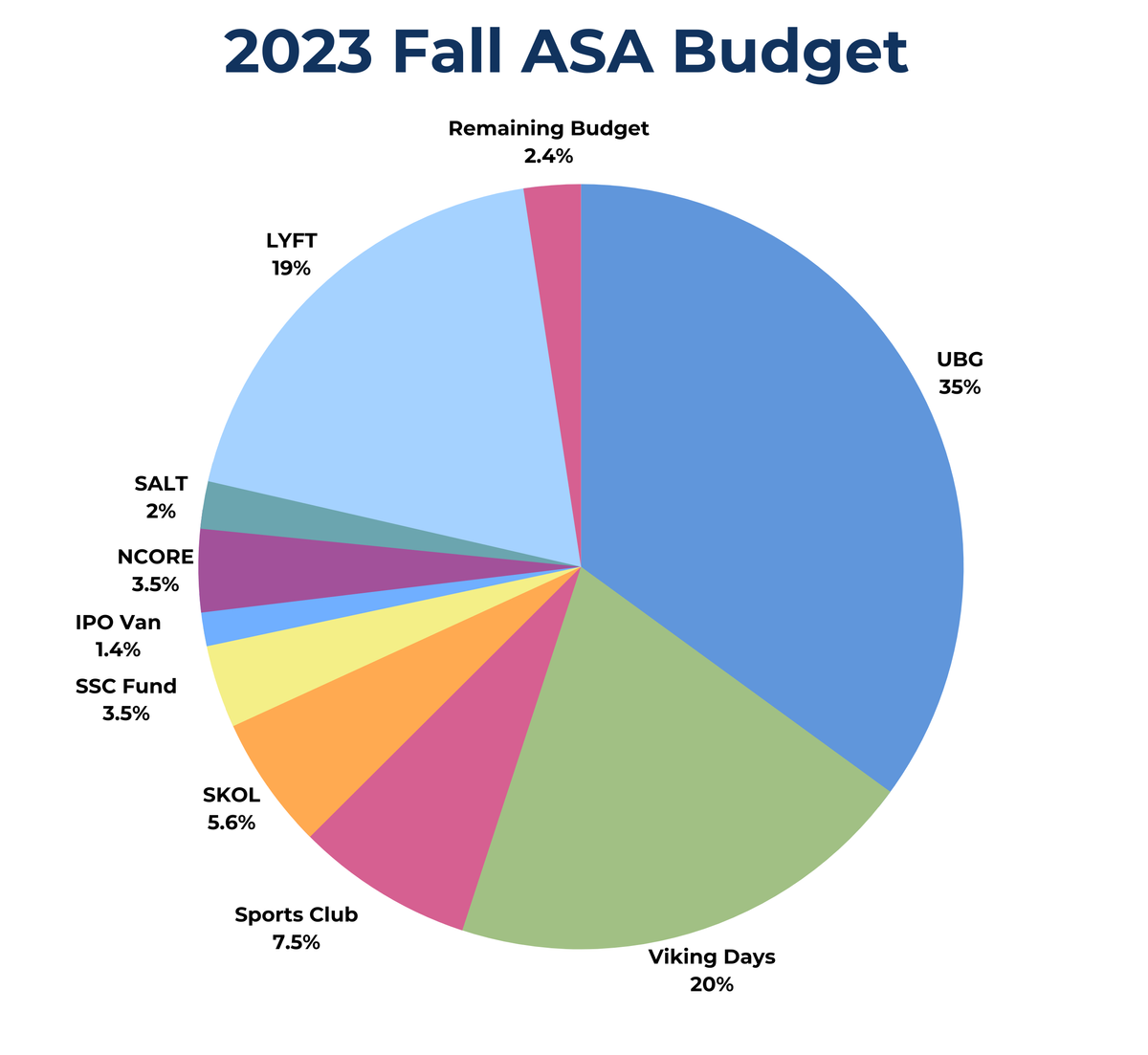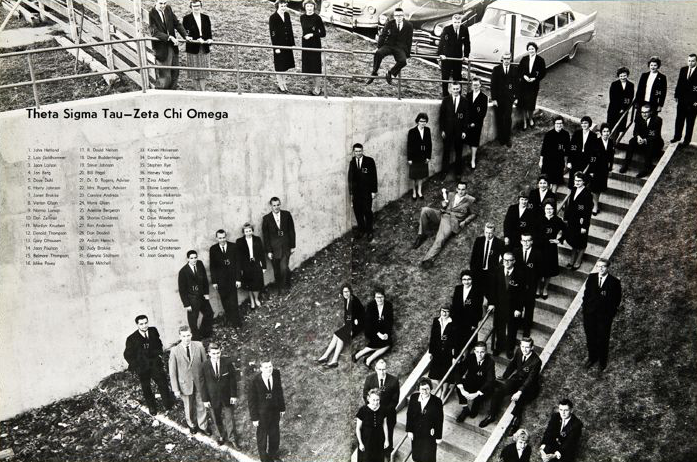ASA manages tighter budget post-pandemic

The Augustana Student Association has been operating with a slim percent of its fall budget after a decreased financial surplus from previous years and a return to pre-pandemic allocations made less non-allocated money available.
A smaller percentage of non-allocated funds means ASA has had less money to direct towards senator projects and has had to be cautious in how much it gives to funding requests from ASA recognized student organizations.
However, ASA President Lauren Teller said the tighter budget has offered ASA opportunities to implement improved structures and regulations around spending to better support future senates.
“We haven’t faced a year in a while in my time on ASA and my time at Augie,where we have had to be this intentional about spending our money, this fiscally conservative or responsible,” Teller said.
ASA recorded a $158,000 allocation from student fees for the 2023 fall semester, a slight increase from the amount it received in fall 2022.
Each semester, ASA must distribute significant portions of its budget to what it calls “tier-one organizations.” This fall, just over $55,000 of its budget went to the Union Board of Governors and $31,600 went to Viking Days.
ASA reserved $30,020 for the Lyft program this fall, its third largest allocation. Allocations to Sports Club, SKOL, Serving and Learning Together and the Student Success Center fund added up to about 18.6% of the total fall budget.
With $5,530 going to NCORE — a diversity, equity and inclusion leadership summit — and $2,250 directed towards a van for the International Programs Office, ASA has only about 2.4% of its fall allocation left and an estimated 8.4% of its yearly allocation.
ASA is using its remaining budget to finance the community development fund, leadership development fund, mini grants and service opportunity fund and non-budgeted items.
“We want our system to be more financially responsible in a way because we want to give money to every club and every entity that comes on campus,” senior Vedant Thakkar, vice chair of the finance committee, said. “But given that we have decreased capacity to fund, our hands are tied in some aspects.”
Nearly three months into the fall semester, ASA has spent $3,991 on approving students and student organizations’ requests for funding, $5,100 on fall training and $10,457 paying for summer Lyft rides.
It also has reserved $15,000 for a project that would bring solar panels to campus, which the previous senate approved. That leaves about $23,509 budgeted for student organizations for the rest of the year and $1,414 in the “free-to-spend” category.
“[Teller] and Henry [Sule] have the really difficult leadership role of being the first in a couple of years that has to say no because those resources are dwindling,” Checka Leinwall, acting dean of students and ASA’s adviser, said. “They’re doing the best they can in an environment where we’ve had a lot of ‘yes’ because we’ve had a lot of money.”
According to Thakkar, the 2022-2023 senate spent $7,600 on SOFs, $15,586 on the CDF, $9,150 on the LDF and $910 on mini grants. For this academic year, Thakkar said the finance committee recommends total costs on these funds do not exceed $27,500.
“These are soft caps. We want to keep our spending within these bounds in order to stay positive, but the senate can override it,” Thakkar said.
ASA began its fall semester with about $16,100, a slim surplus of money from the former senate in comparison to previous years. However, that surplus went to funding the solar panel project and the Lyft program’s summer expenses.
In order to replace money that would have been lost from the surplus, ASA Treasurer Azam Shaik said ASA had to look at accounts that had more money than they were required or supposed to have. Under a reclamation clause, ASA reclaimed $13,696 from Sports Club and $4,776 from SKOL at the start of the fall semester.
Thakkar said the 2022-2023 ASA operated with a $35,000-50,000 surplus from the senate before it. Teller said the COVID-19 pandemic resulted in fewer clubs requesting funding for events, so the remaining budget continued to carry over into future senate budgets.
With extra money in the budget, Thakkar said ASA funded a number of senator projects and approved several recurring allocations, such as the IPO van and NCORE.
“We spent a lot more money last year, assuming that we had a good chunk of money,” Thakkar said. “What we failed to account for is the other costs that would come in. Since all the senate saw last year was, ‘Oh, we have money. We have to spend it,’ we were more spend happy.”
The senate also restored UBG’s funding from 25% of ASA’s total budget to 35%. Teller said ASA voted to decrease its allocation to UBG in 2020 during the COVID-19 pandemic with the promise of restoring it in the future.
“It is fair to [UBG] to re-increase it, but that’s just kind of a shift,” Teller said. “We had a lot of extra money to allocate to senator projects that now we just don’t have, and that’s okay.”
Although the budget has brought challenges, Teller said ASA has been working to rethink funding structures around programs, like Lyft.
ASA now regulates the number of rides available each semester, and students must apply to receive the program. After recording monthly expense averages of $7,500, Shaik said the Lyft program only cost about $5,000 in October.
Thakkar said the finance committee also now presents funding requests by advising senators to consider the merit of the event and the student organization’s current budget.
On Oct. 1, Augie Dems requested $1,200, but ASA only approved $600. The African Student Union requested $1,500 from ASA to fund its Ethiopian New Year event, and the senate approved $1,334, the exact cost of the catering.
According to senior Benita Manzengo, president of the African Student Union, the club had started the semester with a deficit. After fundraising to cover a significant portion of the deficit, Manzengo said the club turned to ASA to help fund the celebratory event.
Manzengo said the African Student Union requested the $1,500 from ASA in September. However, ASA did not hold its first meeting until Oct. 1.
“We found ways to significantly reduce the cost, but since we already asked for [$1,500], we [thought] we could have the rest of the money cover the deficit that we have so we don’t have to do such intense fundraising to cover that,” Manzengo said.
Manzengo said ASA did not want to set a precedent of covering student organization’s deficits, which she understood.
Teller said the senate is also considering amendments aimed at better fiscal responsibility. One of the amendments passed on Nov. 12, and it ensures ASA does not approve any retroactive funding requests unless by a unanimous vote.
“The amendments that I am pushing through, short term, they’re going to be painful. They’re going to be growing pains,” Thakkar said. “But in the long term, I hope that these amendments are beneficial for ASA and the Augustana community.”
In the coming years, Teller, Thakkar and Shaik said ASA will likely operate on a similar budget with a small percent available for funding requests and senator projects.
“In terms of future planning, what we see is that this is how it’s going to be,” Thakkar said. “ASA won’t have excess money. We will probably end up spending most of our money year to year moving forward. So we do not have that much leeway anymore to fund bigger projects.”
While managing a six-figure budget can seem daunting, Teller said ASA relies on a system of checks and balances and careful attention to detail.
“Money is scary, and money is a big stressor for a lot of people, especially college students,” Teller said. “I understand the worry, but I would encourage people, if they want more information about our budget, to come to our meetings, or email us too. Come to our office hours.”



